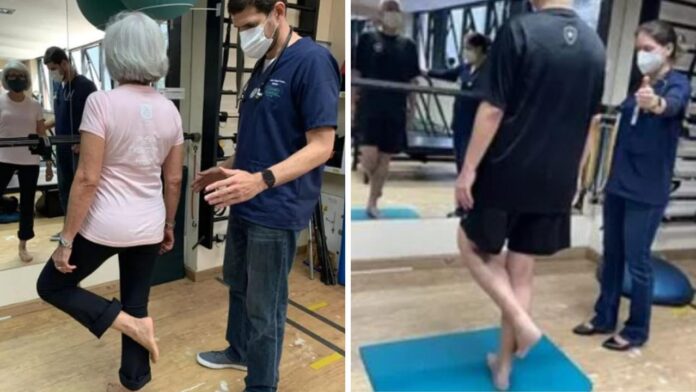[ad_1]
People who can’t stand on one leg for 10 seconds are more likely to die within the next decade than their peers, a new study has suggested.
Researchers asked participants to carry out the simple task, The Sun reports, which involved tucking one leg behind them and having their arms by their sides.
Those who couldn’t hold the position for at least 10 seconds were 84 per cent more likely to pass away during the study, compared to those who could.
Scientists suggested that struggling to balance could be a sign of muscle loss, leaving older people at increased risk of falls.
An estimated 684,000 people die from falls every year worldwide, with many others suffering complications which eventually result in death.
“Our study indicates that the inability to complete a 10-second one-legged stance (OLS) in middle-aged and older participants is related to a higher risk of all-cause mortality and, consequently, to a shorter life expectancy,” study author Dr Claudio Gil Araujo, from CLINIMEX in Rio de Janeiro, Brazil, said.
He and his team studied 1702 men and women aged 51 to 75.
Of these, 348 could not successfully stand on one leg for 10 seconds – mostly the over-70s and those who were overweight or had diabetes.
Researchers then tracked each person for an average of seven years between 2008 and 2020.
In total, 123 people died, with 4.6 per cent of deaths among the group that could balance, and 17.5 per cent the group that could not.
Even when accounting for age, sex, BMI, obesity, and other healthy conditions, mortality was still far higher in the second cohort.
Heart disease and cancer were the most common causes of death, followed by respiratory problems and Covid.
“Ageing is associated with a progressive decline in physical fitness and reductions or impairments in components of aerobic and non-aerobic fitness, including muscle strength, power, flexibility, balance and body composition,” Dr Araujo said.
“It is also well-established that the combination of sarcopenic obesity and loss of flexibility and balance are detrimental for overall health, placing older adults with frailty more prone to falls and other serious adverse medical [consequences].
“Indeed, falls are the second leading cause of unintentional injury-based deaths worldwide.
“Unlike aerobic fitness, muscle strength and flexibility, balance tends to be reasonably preserved until the sixth decade of life, when comparatively, it starts to diminish quickly.
“Nevertheless, balance assessment is not routinely incorporated in the clinical examination of middle-aged and older individuals.”
The authors hope the “remarkably safe” OLS test will be introduced as part of health check-ups, and to help predict a patient’s survival.
“While it is known that good levels of balance are relevant for many daily life activities, there is considerable evidence that loss of balance is also detrimental for health and that some exercise interventions may improve balance,” Dr Araujo, whose work was published in the British Journal of Sports Medicine in 2022, said.
It is not yet known exactly what influence balance training might have on your chances of an early death.
“Improving somebody’s balance and reducing their risk of falls can reduce their risk of hospital admissions and major surgeries, such as hip replacements,” clinical exercise physiologist and director of London’s Longevity Health and Fitness, Victoria Anderson, previously told The Sun.
“Just start with what you can do. Even if it is only a few minutes’ practice a day, it will have more effect than doing nothing.
“People can see a difference in just a couple of weeks. Long-term adherence to exercise is obviously best.
“Once the easier exercises have become manageable and achievable, progress to the intermediate and advanced exercises.”
This article originally appeared on The Sun and was reproduced with permission
[ad_2]
Source link


